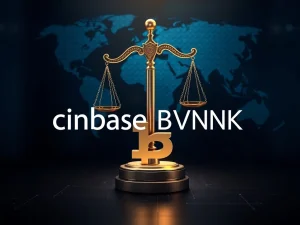FATF Crypto Regulation Unveils Critical Global Crackdown on Stablecoins & DeFi

The world of cryptocurrency is rapidly evolving, and with it, the regulatory landscape. Quietly, but powerfully, the Financial Action Task Force (FATF) is shaping these global rules from behind the scenes. If you’re involved in digital assets, their latest ‘checklist’ isn’t just a suggestion—it’s a crucial hint at where the next wave of regulatory crackdowns will hit, particularly targeting stablecoins and decentralized finance (DeFi).
What is the Driving Force Behind Global FATF Crypto Regulation?
The FATF, an intergovernmental organization, is the global standard-setter for anti-money laundering (AML) and counter-terrorist financing (CFT). While they don’t directly create laws, their recommendations act as a powerful checklist for jurisdictions worldwide. Ignoring these recommendations can lead to severe economic and reputational consequences, making FATF’s guidance virtually mandatory for nations seeking to avoid isolation. The FATF’s annual report outlines how recent regulatory moves by jurisdictions are converging with its global AML/CFT framework, a direct result of years of campaigning to bring cryptocurrencies in line with traditional financial standards. This consistent pressure ensures that global FATF crypto regulation continues to tighten.
How is the Crypto Travel Rule Reshaping Transactions?
A prime example of FATF’s influence is the ‘Travel Rule.’ Extended to cryptocurrencies and exchanges in 2019 as part of Recommendation 15 (R.15), this rule mandates Virtual Asset Service Providers (VASPs) to collect and share user transaction data, much like traditional financial institutions. Progress has been made, with 73% of eligible jurisdictions now having laws to implement it. However, full compliance remains a challenge. For instance, out of 138 jurisdictions, only one—the Bahamas—has achieved full compliance with R.15 as of 2025. This shows a significant journey ahead for many nations.
Here’s a snapshot of the R.15 compliance status:
| Compliance Level | 2024 Jurisdictions | 2025 Jurisdictions |
|---|---|---|
| Fully Compliant | Not specified | 1 (Bahamas) |
| Largely Compliant | 32 | 40 |
| Non-Compliant Removed | Not specified | 3 |
This data highlights the accelerating efforts by jurisdictions to align with FATF standards, yet also underscores the considerable work still required. Jurisdictions like Singapore and Hong Kong, vying to be crypto hubs, are implementing similar licensing requirements for VASPs, adhering closely to the Crypto Travel Rule.
Why Are Stablecoins Under Intense Regulatory Scrutiny?
For the second consecutive year, stablecoins have been spotlighted by the FATF, signaling an impending wave of stablecoin regulation. Their increasing use in illicit finance, including by North Korean actors, is a major concern. The industry saw a staggering $30 trillion in stablecoin volume between May 2024 and 2025, making them a significant target for regulators. While major jurisdictions like the US (with the GENIUS Act) and the EU (with the Markets in Crypto-Assets, MiCA, Regulation) are advancing legislative proposals for stablecoin licensing, the challenge remains in balancing innovation with security. Industry estimates suggest 63% of illicit transaction volumes were denominated in stablecoins, particularly USDT on the Tron network, making them a primary tool for bad actors. As Hedi Navazan of 1inch Labs noted, this is no longer a niche problem.
Is Decentralized Finance Ready for DeFi Regulation?
Decentralized finance (DeFi) presents a unique challenge for regulators due to its inherently permissionless and borderless nature. Despite growing attention, most jurisdictions are struggling to apply FATF standards to DeFi. The FATF’s 2025 report indicates that nearly half of the jurisdictions believe some DeFi platforms should be licensed as VASPs. However, in practice, only four jurisdictions have formally registered DeFi entities, and merely seven have taken supervisory or enforcement action. This highlights a significant gap: 75% of jurisdictions that claim DeFi can fall under VASP regulation have yet to find or license a single DeFi platform. The decentralized nature makes traditional oversight models difficult, yet the FATF is determined to bring clarity to this complex sector, planning targeted papers on offshore crypto platforms and DeFi by next summer.
What Are the Consequences of Ignoring AML CFT Crypto Standards?
The FATF’s influence is not to be underestimated. Its standards are embedded within the United Nations framework, meaning member states face strong incentives to comply. The most potent enforcement tool is the ‘gray listing,’ which places a jurisdiction under increased monitoring, leading to severe economic and reputational consequences. Dubai, a budding crypto hub, was formerly on this list before the UAE was removed in 2024. As Joshua Chu, co-chair of the Hong Kong Web3 Association, explained, regulators are often ‘deadline fighters,’ accelerating efforts to tighten controls before formal reports are released. This urgency ensures that countries implement robust AML CFT crypto frameworks.
A critical debate revolves around whether jurisdictions should permit or prohibit crypto activities. While prohibition might seem like an easy solution, the FATF warns it can be resource-intensive and difficult to enforce. As Navazan stated, ‘When jurisdictions choose to prohibit rather than regulate, they do not eliminate the presence of crypto within their borders. Instead, they relinquish oversight, enforcement leverage and visibility into illicit flows.’ China, an FATF member, has partially prohibited crypto activities, yet its mining pools still control a majority of Bitcoin’s hashrate, demonstrating crypto’s borderless nature and the challenges of full prohibition.
The FATF’s statements, including its annual updates on crypto, offer a clear preview of where global regulations are headed. With stablecoins and DeFi firmly in their sights for 2025, the next wave of compliance measures is inevitable. For businesses and users alike, understanding these evolving standards and proactively adapting is no longer optional. The era of unchecked growth is yielding to one of structured oversight, and those who align with these crucial global guidelines will be best positioned for future success in the digital asset landscape.







